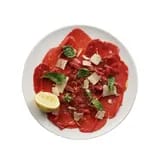Ingredients
Utensils
Bamboo skewers, Stovetop, Pot (small), Frying pan
recipe

Step 1
Cook the rice in boiling water, following the cooking time as recommended on the packaging.

Step 2
Cut the cheese into sticks about 1 cm wide.

Step 3
Prick each piece with a skewer, going all the way to the end.* *Check out our tips for this step

Step 4
Optional : if you have some, add 1 teaspoon of savory soy sauce into your sauce mix.

Step 5
Wrap 1 slice of carpaccio around each piece of cheese. Take care to coat all the cheese well.

Step 6
Lacquer your skewers with the sauce, on all four sides.
Step 7
In a skillet over high heat, cook the skewers for 1 minute on each side.
Step 8
Serve hot with a bowl of rice. It's ready !

If you're using wooden skewers, soak them in water for 30 min before grilling to prevent burning.
- Domitille, Food Editor
Personal notes
Add your own flavor!
Nutrition facts
Average estimated amount for one serving
| Energy | 731 cal. |
| Fat | 32 g |
| Carbohydrates | 60 g |
| Protein | 51 g |
| Fiber | 0.9 g |
Values are based on an average estimate for one serving. All nutrition information presented on Jow is intended for informational purposes only. If you have any concerns or questions about your health, please consult with a health-care professional.
On average, one serving of the recipe "Beef & cheese yakitori" contains 731 Energy, 32 g of Fat, 60 g of Carbohydrates, 51 g of Protein, 0.9 g of Fiber.
Price per portion
| € | Nos recettes à -2 € par portion |
| €€ | Nos recettes entre 2 € et 4 € par portion |
| €€€ | Nos recettes à +4 € par portion |
Please note, the price above is dependent on your grocer and the available products in the grocery store you chose.
Scores


D Nutri-score
The Nutri-score is an indicator intended for understanding nutritional information. Recipes or products are classified from A to E according to their food composition to promote (fiber, proteins, fruits, vegetables, legumes, etc.) and foods to limit (energy, saturated fatty acids, sugars, salt, etc.).
D Green-score
The Green-score is an indicator representing the environmental impact of food products. The recipes or products are classified from A+ to F. It takes into account several factors on the pollution of air, water, oceans, soil, as well as the impacts on the biosphere. These impacts are studied throughout the product life cycle.
Retrieving reviews...



